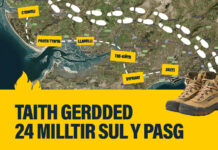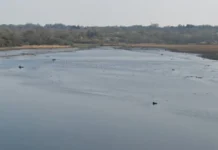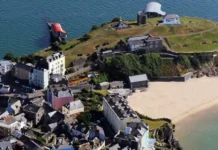FROM harbour porpoises and grey seals to Pacific oysters and sea lettuce, a colourful new guide is being launched to document Swansea Bay’s rich coastal wildlife.
The guide, which will be available at the Civic Centre, the 360 Beach and Watersports Centre and the Tourist Information Office on Plymouth Street, has been put together by Swansea Council’s Nature Conservation Team, thanks to funding from Natural Resources Wales and the Welsh Government.
It covers the coastal stretch between west pier and Mumbles pier, is colour-coded and split into nine sections that focus on Swansea Bay’s sand dunes, strandlines, sandy shores, shorebirds, rock pools, boulders and bare rocks. Swansea Bay’s offshore areas and non-native species are also included.
Some of the off-shore birdlife includes northern gannets, cormorants and razorbills. Wildlife typically found in Swansea Bay’s rock pools includes common hermit crabs, common starfish and grey sea slugs.
The guide includes a photo and a brief description of each of the many plants and animals mentioned.
Cllr Mark Child, Swansea Council’s Cabinet Member for Wellbeing and Healthy City, said: “Many local people and visitors to Swansea Bay mightn’t know just how fascinating and diverse Swansea Bay’s range of coastal and marine plant and animal life really is. The whole of Swansea Bay is a Site of Importance for Nature Conservation and about two-thirds of it is designated as a Site of Special Scientific Interest. Some of our coastal and marine plant and animal species are of great importance in Wales, which is why they’re protected by the council’s Local Biodiversity Action Plan.
“The aim of this new guide is to help local people and visitors to Swansea Bay identify and record their finds, and to encourage them to look after this special place. It will be available in time for the peak summer season for residents and tourists to make the most of and we’re also going to put it on our website for people to download and print off themselves.”
The guide also includes tips on how people can help look after Swansea Bay’s wildlife. Some of the tips include keeping dogs on leads, taking all litter home with you and reporting anything unusual that’s washed up on the beach. A map is also included that shows the locations of car parks, toilets, cafes, tourist facilities and viewing points close to the seaside.
The new guide is part of an overall project to improve interpretation on Swansea Bay. A ‘Wildlife on your Doorstep’ leaflet and a nature calendar with month to month guides on what to see and where are also available, and more interpretation panels will soon be introduced on the promenade.
Help keep news FREE for our readers
Supporting your local community newspaper/online news outlet is crucial now more than ever. If you believe in independent journalism, then consider making a valuable contribution by making a one-time or monthly donation. We operate in rural areas where providing unbiased news can be challenging. Read More About Supporting The West Wales Chronicle























